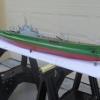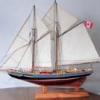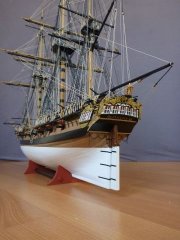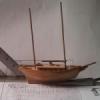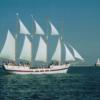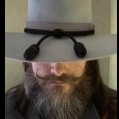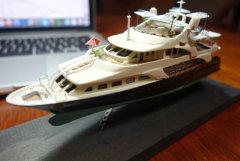-
Posts
3,568 -
Joined
-
Last visited
Reputation Activity
-
 Piet got a reaction from canoe21 in Surabaya by Piet - 1/80 - Mid 17th-Century VOC ship
Piet got a reaction from canoe21 in Surabaya by Piet - 1/80 - Mid 17th-Century VOC ship
Again my thanks for all the likes!!!!
Good to hear you are still busy with ship modeling Dirk. I'm now very curious finding out what you are up to. looking forward seeing it.
Yeah Remco, I plumb forgot about using a drill bit for making the eyelets. Sometimes the most obvious is overlooked. So you mean this way
It's still a tad too large but the next drill bit down in size is broken.
Cheers,
-
 Piet got a reaction from IgorSky in Majellan by Omega1234 - FINISHED - 1/200 - Luxury 37 m Motor Yacht - Miniature
Piet got a reaction from IgorSky in Majellan by Omega1234 - FINISHED - 1/200 - Luxury 37 m Motor Yacht - Miniature
That's beginning to look very nice Patrick. re Ben's comments - that's why I don't like composite structural elements in aircraft. Even secondary structures I have my misgivings on because when they fail it'll effect the primaries.
In any case, we don't have to worry about all that stress - load - stuff in models
Cheers,
-
 Piet got a reaction from kier in Syren by JesseLee - FINISHED - Model Shipways - scale: 1:64
Piet got a reaction from kier in Syren by JesseLee - FINISHED - Model Shipways - scale: 1:64
Brilliant way to work around the "no solder" issue. The results are what counts JesseLee. It's looking really very good.
Cheers,
-
 Piet got a reaction from michael mott in Surabaya by Piet - 1/80 - Mid 17th-Century VOC ship
Piet got a reaction from michael mott in Surabaya by Piet - 1/80 - Mid 17th-Century VOC ship
Again my thanks for all the likes!!!!
Good to hear you are still busy with ship modeling Dirk. I'm now very curious finding out what you are up to. looking forward seeing it.
Yeah Remco, I plumb forgot about using a drill bit for making the eyelets. Sometimes the most obvious is overlooked. So you mean this way
It's still a tad too large but the next drill bit down in size is broken.
Cheers,
-
 Piet got a reaction from canoe21 in Surabaya by Piet - 1/80 - Mid 17th-Century VOC ship
Piet got a reaction from canoe21 in Surabaya by Piet - 1/80 - Mid 17th-Century VOC ship
Thanks everyone for the likes, it very much appreciated.
Thought it's about time for an update. Have been busy with other things besides ship building but dit spend some good quality time in the shipyard. Still busy with the gun tackle, which is going very slow due to the size of the pulleys. In retrospect I should have made them 5 mm long instead of the 3.5 or so.
Am still thinking about redoing them but now that I have put the brass wire braces on eight of them I may just stick it out. Perhaps a few that are really too small to handle but we'll see how it goes.
So far I guess that it takes me about 4 to 5 hours per cannon to make the hardware but not including the actual fastening the tackle to the ship and coiling the ropes.
I decided to make the pulley strops from brass wire instead of thread. It's a little more difficult but it allows me to make the strop, eyelet and hook for the single sheaf pulleys from one piece of brass wire. The double sheaf pulleys are easier because they don't need the eyelet on one end.
Below are a few pics with explanations for my own records. Years from now I like to know how I did things. I did improve on them as time went by but that'll also be explained with the pics.
This shows the method of making the eyelet on the single sheaf pulley strop. A piece of brass rod winding the brass wire around it one turn. I developed a simpler method the next day. That'll be shown in tomorrow's post.
This shows a piece of 0.3 mm brass wire being wrapped around the pulley block. I had to keep the eyelet from unwinding by pinning it with a sewing pin. This too I fixed the next day by spot-soldering the eyelet. By twisting the hook-end the tension tended to untwist it.
I tried to use only one twist on the hook-end to reduce extra bulk with too much of a brass lump. One end will be cut off with nail clippers and the other end is bent into a hook.
This shows the completed strop with an eyelet on one end for the pull rope and the other end with a hook to attach the pulley to the deck or bulwark. The rope trough the eyelet is now ready to be spliced.
How to splice scale rope fro rather thin cords. I cut short pieces of very thin sowing thread and took it apart into its three single threads. I removed the cotton parts to get to the nylon or Dacron threads. I now had very fine but strong threads to use as splice material. It looks thin here but it's about 3 X as thick as a human hair but a lot stronger. It really blended into the "rope" to make it look like a real splice. I'm happy with the result and simple method.
This shows the splicing procedure being started. I made a single overhand knot with the thin thread just behind the eyelet. From there I continued making single knots, alternating from one side then to the opposite side with about 10 knots. I finished it of with a good dab of nail polish that i squeezed into the "splice" with my fingers.
This shows the completed splice and completed pulley block. The only thing left is the blackening, which will be done after all the pulleys are completed.
This shows the double sheaf pulley block with it's strop installed.
Cheers,
-
 Piet got a reaction from flying_dutchman2 in Surabaya by Piet - 1/80 - Mid 17th-Century VOC ship
Piet got a reaction from flying_dutchman2 in Surabaya by Piet - 1/80 - Mid 17th-Century VOC ship
Thanks everyone for the likes, it very much appreciated.
Thought it's about time for an update. Have been busy with other things besides ship building but dit spend some good quality time in the shipyard. Still busy with the gun tackle, which is going very slow due to the size of the pulleys. In retrospect I should have made them 5 mm long instead of the 3.5 or so.
Am still thinking about redoing them but now that I have put the brass wire braces on eight of them I may just stick it out. Perhaps a few that are really too small to handle but we'll see how it goes.
So far I guess that it takes me about 4 to 5 hours per cannon to make the hardware but not including the actual fastening the tackle to the ship and coiling the ropes.
I decided to make the pulley strops from brass wire instead of thread. It's a little more difficult but it allows me to make the strop, eyelet and hook for the single sheaf pulleys from one piece of brass wire. The double sheaf pulleys are easier because they don't need the eyelet on one end.
Below are a few pics with explanations for my own records. Years from now I like to know how I did things. I did improve on them as time went by but that'll also be explained with the pics.
This shows the method of making the eyelet on the single sheaf pulley strop. A piece of brass rod winding the brass wire around it one turn. I developed a simpler method the next day. That'll be shown in tomorrow's post.
This shows a piece of 0.3 mm brass wire being wrapped around the pulley block. I had to keep the eyelet from unwinding by pinning it with a sewing pin. This too I fixed the next day by spot-soldering the eyelet. By twisting the hook-end the tension tended to untwist it.
I tried to use only one twist on the hook-end to reduce extra bulk with too much of a brass lump. One end will be cut off with nail clippers and the other end is bent into a hook.
This shows the completed strop with an eyelet on one end for the pull rope and the other end with a hook to attach the pulley to the deck or bulwark. The rope trough the eyelet is now ready to be spliced.
How to splice scale rope fro rather thin cords. I cut short pieces of very thin sowing thread and took it apart into its three single threads. I removed the cotton parts to get to the nylon or Dacron threads. I now had very fine but strong threads to use as splice material. It looks thin here but it's about 3 X as thick as a human hair but a lot stronger. It really blended into the "rope" to make it look like a real splice. I'm happy with the result and simple method.
This shows the splicing procedure being started. I made a single overhand knot with the thin thread just behind the eyelet. From there I continued making single knots, alternating from one side then to the opposite side with about 10 knots. I finished it of with a good dab of nail polish that i squeezed into the "splice" with my fingers.
This shows the completed splice and completed pulley block. The only thing left is the blackening, which will be done after all the pulleys are completed.
This shows the double sheaf pulley block with it's strop installed.
Cheers,
-
 Piet got a reaction from canoe21 in Surabaya by Piet - 1/80 - Mid 17th-Century VOC ship
Piet got a reaction from canoe21 in Surabaya by Piet - 1/80 - Mid 17th-Century VOC ship
Thanks everyone for visiting my shipyard, your comments and also for the likes. As usual it's very much appreciated.
Yes, for simulating the splicing of rope in this small scale is near impossible and I really didn't want to spend the time and effort to do so. In the end I think that my method works out acceptable.
As mentioned in my previous post I am using a different method in making the little eyelets on one end of the pulley strap. It's done in a few seconds but I have to be careful not making the eyelets too small. Has happened to a few of them but making new ones is now a no brainer
Stropping the pulleys seems to be going a lot faster now with only a few redoes. A teensy drop of soft solder on the eyelet part and after the first twist on the hook part secures the strop nicely to the pulley block. Actually, the "splicing" of the "ropes" takes more time, go figure.
Here is the sequence go how I am now making the strops for the single sheaf pulleys.
Step 1. Take short piece of brass wire (I used 0.3 mm - I would have liked thinner) and make a loop.
Step 2. Grap the loop at its end in a pair of pliers, making sure not to cover too much of the loop end other wise the eyelet will bee too large. Conversely, too little and the eyelet will be too small for the "rope." It all depends on the rope size.
Cheers,
Step 3. Pull each end of the brass wire to tighten the loop and presto, you should have a nice eyelet.
Here is the completed eyelet - sorry for the blurry pic, camera shake
Cheers,
-
 Piet got a reaction from cog in Surabaya by Piet - 1/80 - Mid 17th-Century VOC ship
Piet got a reaction from cog in Surabaya by Piet - 1/80 - Mid 17th-Century VOC ship
Again my thanks for all the likes!!!!
Good to hear you are still busy with ship modeling Dirk. I'm now very curious finding out what you are up to. looking forward seeing it.
Yeah Remco, I plumb forgot about using a drill bit for making the eyelets. Sometimes the most obvious is overlooked. So you mean this way
It's still a tad too large but the next drill bit down in size is broken.
Cheers,
-
 Piet got a reaction from Elijah in Syren by JesseLee - FINISHED - Model Shipways - scale: 1:64
Piet got a reaction from Elijah in Syren by JesseLee - FINISHED - Model Shipways - scale: 1:64
Brilliant way to work around the "no solder" issue. The results are what counts JesseLee. It's looking really very good.
Cheers,
-
 Piet got a reaction from mtaylor in Surabaya by Piet - 1/80 - Mid 17th-Century VOC ship
Piet got a reaction from mtaylor in Surabaya by Piet - 1/80 - Mid 17th-Century VOC ship
Again my thanks for all the likes!!!!
Good to hear you are still busy with ship modeling Dirk. I'm now very curious finding out what you are up to. looking forward seeing it.
Yeah Remco, I plumb forgot about using a drill bit for making the eyelets. Sometimes the most obvious is overlooked. So you mean this way
It's still a tad too large but the next drill bit down in size is broken.
Cheers,
-
 Piet got a reaction from flying_dutchman2 in Surabaya by Piet - 1/80 - Mid 17th-Century VOC ship
Piet got a reaction from flying_dutchman2 in Surabaya by Piet - 1/80 - Mid 17th-Century VOC ship
Thanks everyone for visiting my shipyard, your comments and also for the likes. As usual it's very much appreciated.
Yes, for simulating the splicing of rope in this small scale is near impossible and I really didn't want to spend the time and effort to do so. In the end I think that my method works out acceptable.
As mentioned in my previous post I am using a different method in making the little eyelets on one end of the pulley strap. It's done in a few seconds but I have to be careful not making the eyelets too small. Has happened to a few of them but making new ones is now a no brainer
Stropping the pulleys seems to be going a lot faster now with only a few redoes. A teensy drop of soft solder on the eyelet part and after the first twist on the hook part secures the strop nicely to the pulley block. Actually, the "splicing" of the "ropes" takes more time, go figure.
Here is the sequence go how I am now making the strops for the single sheaf pulleys.
Step 1. Take short piece of brass wire (I used 0.3 mm - I would have liked thinner) and make a loop.
Step 2. Grap the loop at its end in a pair of pliers, making sure not to cover too much of the loop end other wise the eyelet will bee too large. Conversely, too little and the eyelet will be too small for the "rope." It all depends on the rope size.
Cheers,
Step 3. Pull each end of the brass wire to tighten the loop and presto, you should have a nice eyelet.
Here is the completed eyelet - sorry for the blurry pic, camera shake
Cheers,
-
 Piet got a reaction from mtaylor in Syren by JesseLee - FINISHED - Model Shipways - scale: 1:64
Piet got a reaction from mtaylor in Syren by JesseLee - FINISHED - Model Shipways - scale: 1:64
Brilliant way to work around the "no solder" issue. The results are what counts JesseLee. It's looking really very good.
Cheers,
-
 Piet got a reaction from JesseLee in Surabaya by Piet - 1/80 - Mid 17th-Century VOC ship
Piet got a reaction from JesseLee in Surabaya by Piet - 1/80 - Mid 17th-Century VOC ship
Again my thanks for all the likes!!!!
Good to hear you are still busy with ship modeling Dirk. I'm now very curious finding out what you are up to. looking forward seeing it.
Yeah Remco, I plumb forgot about using a drill bit for making the eyelets. Sometimes the most obvious is overlooked. So you mean this way
It's still a tad too large but the next drill bit down in size is broken.
Cheers,
-
 Piet got a reaction from mtaylor in Majellan by Omega1234 - FINISHED - 1/200 - Luxury 37 m Motor Yacht - Miniature
Piet got a reaction from mtaylor in Majellan by Omega1234 - FINISHED - 1/200 - Luxury 37 m Motor Yacht - Miniature
That's beginning to look very nice Patrick. re Ben's comments - that's why I don't like composite structural elements in aircraft. Even secondary structures I have my misgivings on because when they fail it'll effect the primaries.
In any case, we don't have to worry about all that stress - load - stuff in models
Cheers,
-
 Piet got a reaction from Jack12477 in Surabaya by Piet - 1/80 - Mid 17th-Century VOC ship
Piet got a reaction from Jack12477 in Surabaya by Piet - 1/80 - Mid 17th-Century VOC ship
Again my thanks for all the likes!!!!
Good to hear you are still busy with ship modeling Dirk. I'm now very curious finding out what you are up to. looking forward seeing it.
Yeah Remco, I plumb forgot about using a drill bit for making the eyelets. Sometimes the most obvious is overlooked. So you mean this way
It's still a tad too large but the next drill bit down in size is broken.
Cheers,
-
 Piet got a reaction from Dimitris71 in Majellan by Omega1234 - FINISHED - 1/200 - Luxury 37 m Motor Yacht - Miniature
Piet got a reaction from Dimitris71 in Majellan by Omega1234 - FINISHED - 1/200 - Luxury 37 m Motor Yacht - Miniature
That's beginning to look very nice Patrick. re Ben's comments - that's why I don't like composite structural elements in aircraft. Even secondary structures I have my misgivings on because when they fail it'll effect the primaries.
In any case, we don't have to worry about all that stress - load - stuff in models
Cheers,
-
 Piet got a reaction from Omega1234 in Majellan by Omega1234 - FINISHED - 1/200 - Luxury 37 m Motor Yacht - Miniature
Piet got a reaction from Omega1234 in Majellan by Omega1234 - FINISHED - 1/200 - Luxury 37 m Motor Yacht - Miniature
That's beginning to look very nice Patrick. re Ben's comments - that's why I don't like composite structural elements in aircraft. Even secondary structures I have my misgivings on because when they fail it'll effect the primaries.
In any case, we don't have to worry about all that stress - load - stuff in models
Cheers,
-
 Piet reacted to EdT in Young America 1853 by EdT - FINISHED - extreme clipper
Piet reacted to EdT in Young America 1853 by EdT - FINISHED - extreme clipper
Hello Marc,
It was good to meet you at the conference and I am glad you will find the book useful.
All the best,
Ed
-
 Piet reacted to flying_dutchman2 in Young America 1853 by EdT - FINISHED - extreme clipper
Piet reacted to flying_dutchman2 in Young America 1853 by EdT - FINISHED - extreme clipper
I received vol. 1 of the YA as a door price at the Mystic conference. It is beautiful, well illustrated, and with step-by-step instruction. I have browsed the book and the plans and the one thing I immediately noticed are the methods used to build this ship. I can apply these methods to any ship I built in the future.
Presently this ship is way above my building grade, but who knows, maybe in the future.
Even if people do not build clippers this book it should be in everybody's library.
Marc
-
 Piet reacted to EdT in Young America 1853 by EdT - FINISHED - extreme clipper
Piet reacted to EdT in Young America 1853 by EdT - FINISHED - extreme clipper
Thank you, David. I use artist's acrylics, except on metal. Acrylic gouache (usually Jo Sonja tubes) and liquid acrylics ( usually Golden Fluid Acrylics). The gouache dries dead flat and the Golden has a gloss.
Ed
-
 Piet reacted to dgbot in Young America 1853 by EdT - FINISHED - extreme clipper
Piet reacted to dgbot in Young America 1853 by EdT - FINISHED - extreme clipper
Fantastic workmanship Ed. What brand of paint are you using?
David B
-
 Piet reacted to GLakie in Young America 1853 by EdT - FINISHED - extreme clipper
Piet reacted to GLakie in Young America 1853 by EdT - FINISHED - extreme clipper
Truly outstanding work Ed.
-
 Piet reacted to ScottRC in Young America 1853 by EdT - FINISHED - extreme clipper
Piet reacted to ScottRC in Young America 1853 by EdT - FINISHED - extreme clipper
Wow! Learning a lot from what you are showing.
-

-
 Piet reacted to EdT in Young America 1853 by EdT - FINISHED - extreme clipper
Piet reacted to EdT in Young America 1853 by EdT - FINISHED - extreme clipper
Young America - extreme clipper 1853
Part 120 – Main Deck Cabin 2
Work on the deck cabin continued. In the first picture the starboard side has been installed and the forward bulkhead is in the process.
All the bulkheads were made to fit into the rabbet on the coaming. In the next picture, both end bulkheads are in place and the framing for the port side is being installed.
Pine strips with wedges were used along the floor to hold the studs against the coaming at the bottom. The reinforcing pine batten is still pasted in place. This side of the structure will be left open for visibility into the framing below.
In the next picture the pine batten has been removed and masking tape has been placed on the deck framing to prevent small pieces from dropping through. These can now be very difficult to extract. The first of the rounded up roof rafters are being fitted.
In the next picture these have been installed. A number of them have been fitted with hanging knees to provide some wind bracing. This structure had to be quite strong.
In the next picture the masking tape has been removed and the tops of the end bulkheads trimmed out in readiness for the roof planking.
The next picture shows the initial strake of 3” x 7” roof planking being aligned against a straightedge and pinned in place.
There is a strake with a water stop to be fitted outside of this one, but I wanted to paint that first and use the next inner strakes for alignment. The next picture shows that outer strake being fitted against the two initially installed planks.
In the next picture the planking has progressed almost to the centerline.
The last picture shows the finished roof.
The ends of the planks have been sanded square and notches cut through the water stop for the two transverse skid beams that will cross the roof. The roof has been coated with acrylic sanding sealer, sanded smooth and painted with the same color blue as the waterways. The paint is acrylic.
The next task is to construct the coach – the entrance to the cabin deck.
Ed


